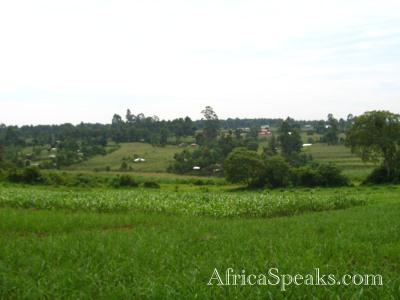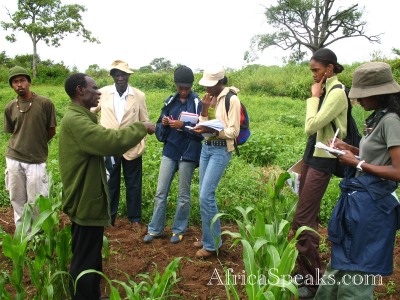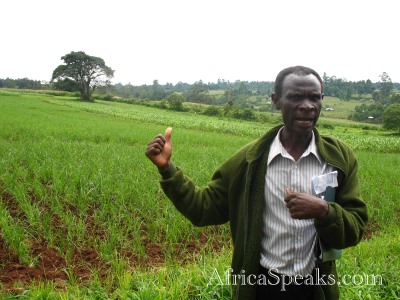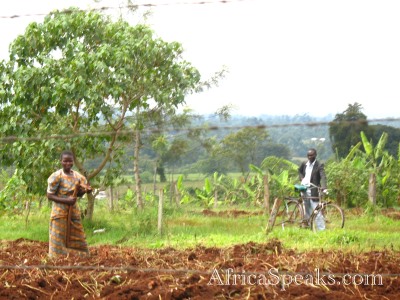The original URL of this article is:
www.africaspeaks.com/kenya/05082006.html
Agriculture In Kenya
by Akilah Stewart
August 05, 2006
UWI Students Trip to Kenya
 | | | Akilah Stewart | |
Kenya is approximately 587,000 squared kilometers in area, with 11,200 squared kilometers of that area covered in water, such as Lake Nalubale, also known as Lake Victoria. However, of all this space only 20% is of some potential value for agricultural purposes because the rest is arid or semi-arid lands. Interestingly enough, roughly a third of that 20%, or just 7% of all Kenyan land is arable and supports the raising of crops and rearing of livestock that is of vital importance to the Kenyan way of life.
According to the Central Bureau of Statistics, which is a department in the Ministry of Finance and Planning in the Kenyan Government, 'Agriculture accounts for approximately one-quarter of the Gross Domestic Product, employs more than two-thirds of the labour force, accounts for about 70% of the export earnings (excluding refined petroleum), generates almost all the country’s food requirements and provides a significant proportion of raw materials for the agricultural resource-based industrial sector.
 Millet field
Millet field
The agricultural products are diverse and include cash crops such as coffee, tea, sisal and sugar. Grains, cotton, tropical fruit and coconuts are also grown. Staple crops include maize, pulses, millet, bananas, sweet potatoes and potatoes. In terms of animal production, cattle raising for dairying and for meat is very important. In addition, hides, skins and wool are produced for both domestic consumption and for exportation.
We visited the Rift Valley, Nyanza and Western provinces of Kenya which are all fertile lands, and as such, the area attracted former European settlers. Indeed, the influence and importance of agriculture was forever evident through the countless corn and sugarcane fields visible from the major roads we traveled on. As stated before, agriculture is very important to the Kenyan economy and especially as it satisfies such a large portion of the demand for food in some of the subsistent dominant areas of the country. Crops are not only produced for consumption, but for the rearing of animals and hence, indirectly, for milk production.
Aside from its major importance in food production, agriculture has been combined extensively with forestry in Kenya. The practice of agroforestry is such that even more benefits can be derived from that limited 7% of arable land previously noted. As such, another major product is lumber. The general policy and attitudes adopted by the people and their government is channeled considerably in the direction of reforested lands. It was noted from William Toili, a lecturer at the Western University of Science and Technology, that at the time of Independence Kenya had 10% forest cover. From then to now, there is just 2% virgin forest, hidden away in places like Kakamega, which we were so fortunate to have been able to visit.
 Natural Science students from the University of the West Indies take notes
Natural Science students from the University of the West Indies take notes
There were very many tree plantations and tree farms throughout the areas that we visited. As noted before, we even devoted an entire week to working at the Shikunga Resource Centre, which has a tree nursery on its compound. Aside from those forestry and agroforestry institutions and organizations run for commercial purposes and those run by the government, there were also those run by individuals. Just as it is common here to plant a little 'chadonn-beni, a plum tree or some citrus in your backyard, for them, having a dozen or two Eucalyptus plants which would be ready for use in three years time, is perhaps beyond common. It will forever be cemented in the minds of us the day that we actually fell trees, shaved them and then hammered them up to build a mud hut using Eucalyptus trees from just across the road. Eucalyptus is integral to the rural life of Kenya, as it is able to grow very quickly and just as importantly, it can rejuvenate from its stump.
Aside from its value in its use for building of homes and associated uses such as furniture, fuel and animal fodder, trees are used for the paper industry in Kenya. The largest supplier of paper in eastern Africa is located in Kenya, in the industrial town of Webuye in the district of Bungoma. The Pan African Paper Mills in fact, is the largest paper factory in the region. (We were supposed to go there.)
In terms of rearing of livestock, a lot of emphasis is placed on indigenous cattle rearing. The FAO Economic and Social Department, Statistics Division, ranks the commodity of indigenous cattle number two in terms of dollar value derived from its production, and interestingly enough, is second only to the value derived from cow milk, whole and fresh. Both products are very much part of Kenyan life. Indeed, everyday, every single day, we were served hot fresh cows milk, to be used in the making of tea, coffee, cocoa and our very special Milo. So big is livestock production in Kenya that there is a separate ministry called the Ministry of Livestock and Fisheries, aside and apart from the Ministry of Agriculture.
 Noah, Technical Officer for the Kenyan Agricultural Research Institute
Noah, Technical Officer for the Kenyan Agricultural Research Institute
In the same way that production of trees is not just for horticultural purposes but a means of continuing tradition and supporting rural life, so too is livestock production. This we observed in the Great Rift Valley, home of the Masai Tribe, where herding of cattle and sheep was being practiced in the plains by the locals. The cultural importance of livestock was also noted when a lamb was graciously presented to us and then sacrificed as a showing of the appreciation of our hosts for our visit, and in their way, as a lavish welcome.
On the point of dollar value derived from commodities, tea ranks third, being closely followed by maize. Tea is a major export there and does well because of the large amount of high altitude land available that is so key to the success of tea production. We visited the Tegat Tea Factory in the Kericho Highlands. A tour of this factory facilitated our understanding of the production processes involved and of how much people, in fact, families earn their livelihood from this industry. In the Kenya Tea Development Agency (KTDA), a hugh co-operative of small tea farmers, there are 430,000 individual farmers selling green leaves to 55 factories in the region.
Of a roughly equal significance in terms of employment of people, is maize production. It too involves a very, if not more scientific background than tea production. At the Kenya Agriculture Research Institute (KARI), we were given an overview of the procedures and processes that are involved in maize production there. Maize and a host of other agricultural crops grown for research there, are planted taking into consideration ecological zones, soil types, rain fall patterns, temperature and climate and altitude zonations. Pest control is also researched to a great extent. Integrated Pest Management is practiced and promoted, if only because it is cheaper.
 Workers prepare an agricultural field
Workers prepare an agricultural field
Because it is an integral part of the whole Kenyan culture, agriculture as an academic discipline is greatly focused on. So much so, that there are a host of institutions which are solely geared towards agriculture, such as the Bukura Institute of Agriculture, the Kenya Agricultural Research Institute (KARI) and most notably, the Jomo Kenyatta University of Agriculture. In the Nairobi University, their Faculty of Agriculture teaches such disciplines as Crop Science, Soil Science, Agriculture Economics, Range Management and Crop Protection at degree and masters level. You can also read for a degree in Agricultural Engineering there or in other tertiary institutions such as the Egerton University. But remember, the tertiary enrolment in Kenya is just 2%, so one is left to wonder how far can such qualifications spread in a country with over 30 million people.
UWI Students Trip to Kenya in pictures:
http://rastafarispeaks.com/gallery/Trip_to_Africa_2006
|
|